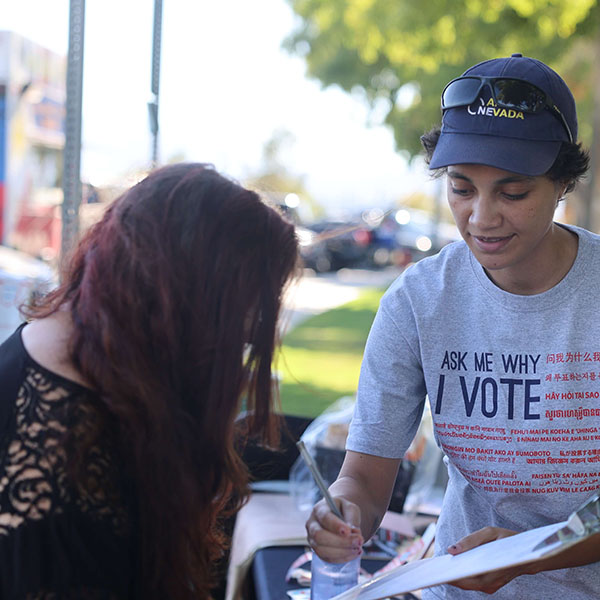Download the Article
Download a PDF of the full article.Executive Summary
At The Bridgespan Group, we are seeing a rise in funders who recognize that impact at scale on the issues they care about requires policy and systems changes. They are considering whether and how to invest in new types of organizations and advocacy efforts, and they have a lot of questions. This article addresses the questions we hear most frequently. It provides research-based, tactical guidance on how, when, and where to consider investing in advocacy efforts. It builds on our previous publications “Audacious Philanthropy” (2017), “When Philanthropy Meets Advocacy” (2018), and is a complement to “Betting on the Tortoise: Policy Incrementalism and How Philanthropy’s Support Can Turn Small Sustained Steps into Big Impact” (2024). It reflects new research, including more than 30 interviews with practitioners and philanthropists. Our interviewees shared that thoughtful, nuanced, and sustained advocacy and policy work can lead to scaled, durable progress on just about any social issue in the United States.
Related content
Bridgespan has a growing body of knowledge work at the intersection of policy, advocacy, and philanthropy.
- For four ways that funders can make strategic, sustained investments in social movements, see “Betting on the Tortoise: Policy Incrementalism and How Philanthropy's Support Can Turn Small Sustained Steps into Big Impact.”
- For a primer on politically active philanthropy, see our 2018 Stanford Social Innovation Review article “When Philanthropy Meets Advocacy.”
- Listen to Bridgespan's Deborah Bielak and William Foster discuss the power of incremental policy change on "The Business of Giving" podcast with host Denver Frederick.
At their most basic, advocacy efforts help to build public awareness, shift narratives, change norms, and engage legislators and decision makers to change policies and spending. This often requires many actors, versus one, and different types of entities, including 501(c)(3)s, 501(c)(4)s, and 527s, different types of nonprofits under the US tax code that have unique and important roles to play. All these efforts require resources, and philanthropic dollars can be critical.
To be sure, the lack of disclosure requirements for 501(c)(4) (referred to as “c4s”) giving and some 527 giving has raised concerns about “dark money,” lack of transparency, and accountability. Inherently, though, funding the full advocacy toolkit means political funding. Regardless of your perspective on money in politics, it is already present and highly influential. Whether or not you engage, it’s critical to understand how it works. On any issue, those opposed to your philanthropic goals may already be engaging in politics in ways that undermine the impact of your giving.
 A One APIA Nevada volunteer talks to a community member during a National Voter Registration event in 2023. (Photo courtesy of One APIA Nevada)Robust advocacy includes voter education and an engaged, invested electorate. It can also mean lobbying policymakers and supporting candidates for elected and appointed positions who back specific policies. These activities may require funding organizations beyond the typical 501(c)(3)s (referred to as “c3s”) that most funders are familiar with. While our interviewees encourage investing across the spectrum of organizations engaged in advocacy, the decision bears deliberation for every philanthropist. Drawing on examples from policy efforts around early childhood education, health equity, and economic mobility, this article provides an overview of how you may effectively fund organizations driving policy and political change on the issues you care about, if you are so interested.
A One APIA Nevada volunteer talks to a community member during a National Voter Registration event in 2023. (Photo courtesy of One APIA Nevada)Robust advocacy includes voter education and an engaged, invested electorate. It can also mean lobbying policymakers and supporting candidates for elected and appointed positions who back specific policies. These activities may require funding organizations beyond the typical 501(c)(3)s (referred to as “c3s”) that most funders are familiar with. While our interviewees encourage investing across the spectrum of organizations engaged in advocacy, the decision bears deliberation for every philanthropist. Drawing on examples from policy efforts around early childhood education, health equity, and economic mobility, this article provides an overview of how you may effectively fund organizations driving policy and political change on the issues you care about, if you are so interested.
“501(c)(4)s enable a full expression of a community’s voice and clear articulation of its priorities,” says Tory Gavito, president of Way to Win, which provides philanthropic and political advisory services. C4s offer valuable flexibility—they can and often do all the advocacy activities of a c3, while allowing deeper engagement in politics and policy advocacy. 527s build on this work by enabling unrestricted political advocacy to elect candidates committed to the social change communities seek. Many of our interviewees noted the value of an integrated strategy and noted that funders can invest in ways that work for them, outlining some of the ways they would recommend investing.
- Support the full extent of c3 advocacy work.
Many funders and nonprofit leaders don’t realize how much work a c3 can do to shape policy, and how that work can have outsized impact. Giving c3 dollars and trusting grantees to use them to the full extent of what’s allowed for a c3—including a limited amount of lobbying—gives funders a chance to gauge their comfort level with advocacy work. - Create the structure to fund c4 and 527 activities, if necessary.
Funders can give across legal structures in several ways to build a portfolio of complementary tools that will accelerate and sustain progress toward their goals. Importantly, if you’re interested in funding the full suite of advocacy activities allowed in c4 and/or 527 organizations—such as unlimited lobbying and political campaign activities—you may need to consider creating an alternative structure. Interviewees shared several examples of families that set up separate legal entities to advance and sustain their philanthropic priorities. On the other hand, individuals giving directly to c3s can also give to c4s and 527s without creating new structures. - Give through intermediary funding organizations.
Intermediary funding organizations and donor-advised funds offer funders a structured, efficient, and high-impact approach to funding c3, c4, and 527 organizations. These organizations take care of administrative burdens, navigate the legal details, and leverage deep experience in advocacy to conduct thorough due diligence. These intermediaries, especially those led by people with direct issue experience, often have the kinds of relationships and insight that equip them to allocate funds to maximize their impact. - Give directly to c4s or 527s –starting with c4 or 527 arms of the c3 organizations you already know.
When deciding which c3s to fund, it's prudent (and entirely legal) for donors to explore if these entities have affiliated c4s and 527s. Organizations with such a structure can use c3 funding to grow their organizational capacity and conduct c3-allowed activities that strengthen community voice and encourage civic participation. These outcomes provide a critical foundation for effective advocacy. They complement this work with c4 work, including more robust lobbying, and the electoral work of 527s. - Collaborate with funders and experts that share your goals.
Funders tell us they often do this work best in community, with a spirit of inquiry and humility. As you increase your commitment to advocacy funding, they suggest you find the funder collaboratives and learning communities on the leading edge of this kind of giving. Collective action in the philanthropic community can move money smarter.
If you do decide to fund advocacy, our interviewees shared the following set of suggestions for how to do it most effectively. Consider the following as a menu of tactics to choose from to tailor to your goals, rather than a suggestion to do them all.
- Consider opportunities to partner on issues, not party lines.
Many of our interviewees underscored the importance of building broad coalitions in service of powerful solutions. Bringing unlikely allies together increases the effectiveness of advocacy work. - Fund at the regional level(s) needed to accomplish your goals.
While many think of funding policy advocacy on the federal level, there are opportunities for transformative impact that require careful and targeted investment across the country, at all levels of government. Working at the state and local levels can result in rapid, incremental change that eventually aggregates to federal level change. - Look to organizations going beyond the norm.
Opportunities exist across the map, and leaders at various levels can spark change on the issues you care about. To advance change on the issues you care about, consider funding organizations that look beyond presidential, Senate and Congress, gubernatorial, and mayoral races (e.g., water boards). Look also to organizations that engage “low propensity” voters—disproportionately people of color. Leaders on the ground know how important it is to mobilize these voters to support legislators championing the issues they care about most, and they know how to get it done. - Give early and stay the course.
Organizations working on political change see funding spike in predictable cycles, but sustained funding over the long term is critical to winning. Many see funding in months leading up to presidential elections, but not in off-cycle or mid-term election years. Policy and advocacy work takes time, decades in many cases, and early, sustained funding allows leaders on the ground to plan for success not just on election day but beyond.
Policy change is a foundational component of social change at a population level. Funders intent on getting to the root of issues they seek to address know this well. Many of them fund with the full suite of advocacy tools to reach their goals, to help communities build and exert power on democratic institutions, to achieve and sustain systemic solutions.
Ultimately, this is about maximizing impact. Many funders overlook or shy away from advocacy and policy work. The funders we interviewed report that using these tools isn’t as fraught or complicated as it may seem, that they can be used to elevate community priorities (as opposed to advancing narrow self-interest), and the payoff is huge for people and communities.






